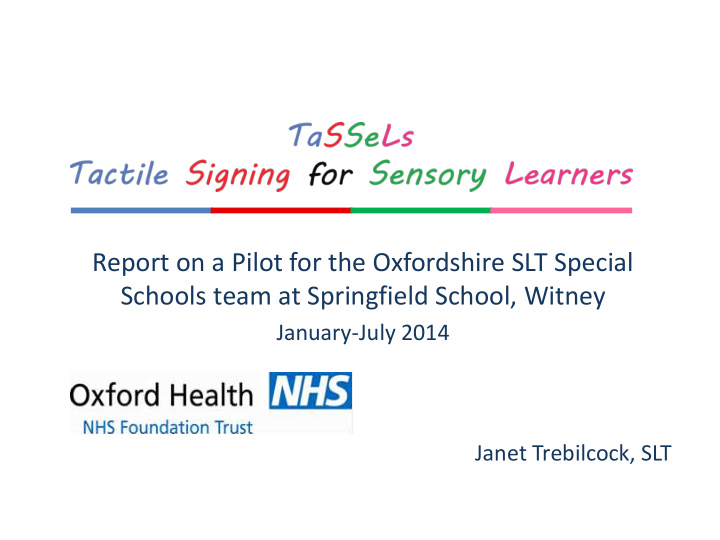



Report on a Pilot for the Oxfordshire SLT Special Schools team at Springfield School, Witney January-July 2014 Janet Trebilcock, SLT
Brief background to the pilot • Need for on-body signs for learners at P1-4 to supplement the Total Communication Environment • Need for commitment to one approach and consistency across the county • Need for co-ordination across teams – SENSS, MSI / VI, Early Years SLT • Awareness of newly-published Tassels approach • Pilot agreed after multi-agency discussions
Overview of Tassels • Developed in Sandwell by Joe Woodall (VI teacher) and Denise Charnock (SLT) • Targeted and functional tactile signs for established everyday routines • Alert signal and hand-under-hand method for fullest participation and active learning • 3 approaches: • Hand-under-hand • Hand-under-hand (adapted) • On-body • Supports comprehension and expression
Strengths of Tassels • RESPECT and DIGNITY • Safeguarding considerations • Multi-agency input • Hand-under-hand methods • Support material – manual, CDRom, DVD, prompt cards, recording systems, targets linked to P levels, training • Signs designed to maximise their communicative potential through touch • Making sense within the chaos
Aims of the pilot • To trial the approach in one Special School • To gain hands-on experience of the approach • To evaluate the impact of the approach for the learners taking part • To evaluate the approach in comparison with other approaches currently in use • To evaluate the approach in the context of possible wider implementation within the county • To identify any future service needs
The Pilot: Key Facts • Introduced to Springfield School Jan 2014 • 10 children from 5 classes, all P1-3 and VI • Teachers and TAs trained in twilight sessions • 3 individually-chosen signs for each learner, increasing to 5 if appropriate • Liaison with parents • Recording
Evaluation of the pilot • IEP Objectives – outcomes • Evaluation forms – quantitative data, descriptors from Jones AP 2001 (“Doorways”) • Evaluation forms – qualitative data • Data collection and analysis – progress expressed as percentage increase for each of the signs in each of the descriptors
Example Scoring Card
Data Analysis: Learners’ Individual Progress 60 50 % Progress 40 30 20 10 0 1 2 3 4 5 6 7 Tolerance Engagement Meaningfulness
Data Analysis: Learners’ Overall Progress 45 40 % Progress 35 30 25 42.13 41.33 20 37.66 33.2 15 26.6 10 3.33 5 6.6 0 1 2 3 4 5 6 7 Overall Progress
Data Analysis: Progress in descriptors
Qualitative Data Analysis • “The sign ‘ready to move’ is particularly helpful to prepare ‘I’ for movement” • “ ’C’ has really responded well to the ‘hoist’ and ‘drink’ and ‘food’ signs and is engaged in these” • “ ‘K’ is more aware of us signing with him” • All teachers happy to continue with the approach
Evaluation: limits of the pilot • Only 7 of original 10 learners’ data analysed • Subjective scoring • No measure of consistency • No evidence of responses to specific signs • No evidence of reasons for progress or lack of it – receptiveness of the learner / severity of complex needs / enthusiasm and skill of staff / number and consistency of repetitions / age of learner etc • Scratched the surface of Tassels
Evaluation: Success of the pilot • Progress evidenced for individuals • Tassels accepted and used enthusiastically, added to tools used in the TCE • Tassels experienced and evaluated • Staff skills increased re: Tassels • Staff skills increased re: cueing, engagement, hand- under-hand techniques
Evaluation: Aims of the Pilot To trial the approach in one Special School To gain hands-on experience of the approach To evaluate the impact of the approach for the learners taking part • To evaluate the approach in comparison with other approaches currently in use - ongoing • To evaluate the approach in the context of possible wider application within the county - ongoing • To identify any future service needs - TRAINING!
Next Steps Disseminate pilot information across teams and with managers • Review and develop approach at Springfield School, e.g. recording, objective setting around P levels, resources • Take forward if consensus across teams • Apply for funding for training – for SLTs and for education staff • Keep learning!
Useful information Manual: Tassels - Tactile Signing for Sensory Learners: For staff working with children and young people Published by Pavilion Publishing and Media Ltd 2012 Cost: £125 Training : Level 1, Level 2 and Bespoke Email: tasselssigning@yahoo.com
Recommend
More recommend